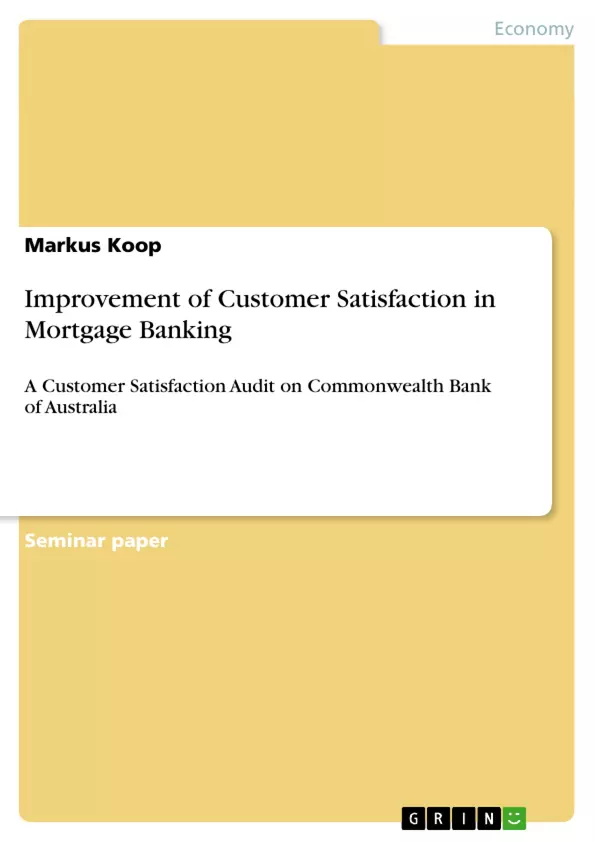Customer Satisfaction - darum geht es in dieser Arbeit. Anhand einer führenden australischen Bank zeigt diese Arbeit, wie Kundenzufriedenheit entsteht, wie man sie beeinflusst und verbessern kann.
Dies umfasst die Problemerkennung, Situationsanalyse, Ermittlung von diversen Strategien zur Behebung des Kundenzufriedenheitsproblems, Evaluierung der Strategien auf Realisierbarkeit und Erfolgsprognose, sowie Anweisungen zur Umsetzung im operationellen Geschäft.
The objective of this report is to increase customer satisfaction of Commonwealth Bank of Australia’s (CBA) first homebuyers mortgage. In regards to this, CBA currently has a low level of customer satisfaction in comparison with the other main banks. Based on the conceptual framework, customers tend to feel dissatisfied with the mortgage service provided by CBA due to the period of time for the mortgage’s approval process as well as the lack of convenience and flexibility of CBA’s services. In an effort to increase satisfaction, the current situation is reviewed resulting in access points to CBA’s weakness in customer satisfaction. Several potential strategies are introduced to tackle the problem. The most promising ones are describes and evaluated in terms of costs and effectiveness to increase customer satisfaction. Finally a “one-stop mortgage centre”-strategy is recommended for implementation in order to decrease customers’ non-financial costs and increase their convenience in first home buyer mortgages.
Inhaltsverzeichnis (Table of Contents)
- EXECUTIVE SUMMARY
- SITUATION AUDIT
- Macro-Environmental Analysis
- Competition
- SWOT Analysis
- Segmentation & Target Market
- PROBLEM STATEMENT AND ANALYSIS
- The Managerial Problem
- The Central Service Problem
- CUSTOMER SATISFACTION STRATEGIES
- Conceptual Framework
- Service Strategies
- Alternative Strategies
- EVALUATION CRITERIA
- ANALYSIS OF THE SERVICE STRATEGIES
- RECOMMENDATIONS
- IMPLEMENTATION
- REFERENCES
Zielsetzung und Themenschwerpunkte (Objectives and Key Themes)
This customer satisfaction audit aims to assess the current state of customer satisfaction with Commonwealth Bank's First Home Buyer loans and identify potential strategies for improvement. The study examines the macro-environmental factors, competitive landscape, and target market of the FHB mortgage market. It also analyzes the bank's current service offerings and identifies areas for improvement.
- Customer satisfaction and its impact on business success
- Macro-environmental factors influencing the FHB mortgage market
- Competitive analysis of the Australian mortgage banking sector
- Segmentation and targeting of the FHB market
- Identifying and evaluating service strategies to enhance customer satisfaction
Zusammenfassung der Kapitel (Chapter Summaries)
The executive summary provides an overview of the findings and recommendations of the audit. The situation audit section examines the macro-environmental factors, competitive landscape, and target market of the FHB mortgage market. This includes a SWOT analysis of Commonwealth Bank's FHB mortgages. The problem statement and analysis chapter identifies the managerial and service problems associated with customer satisfaction.
The customer satisfaction strategies chapter proposes a conceptual framework for evaluating service strategies. This includes a discussion of alternative strategies such as extended business hours and one-stop mortgage centers. The evaluation criteria chapter outlines the metrics used to assess the effectiveness of the proposed strategies. The analysis of the service strategies chapter evaluates the potential impact of the proposed strategies on customer satisfaction.
The recommendations chapter presents a set of actionable recommendations for improving customer satisfaction. The implementation chapter details the timeline and resources required to execute the recommended strategies.
Schlüsselwörter (Keywords)
The study focuses on customer satisfaction, mortgage banking, First Home Buyer loans, market analysis, competitive advantage, service strategies, implementation, and evaluation.
- Arbeit zitieren
- Markus Koop (Autor:in), 2007, Improvement of Customer Satisfaction in Mortgage Banking, München, GRIN Verlag, https://www.grin.com/document/138783



